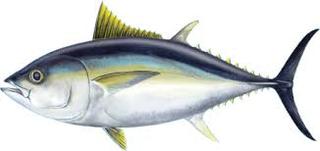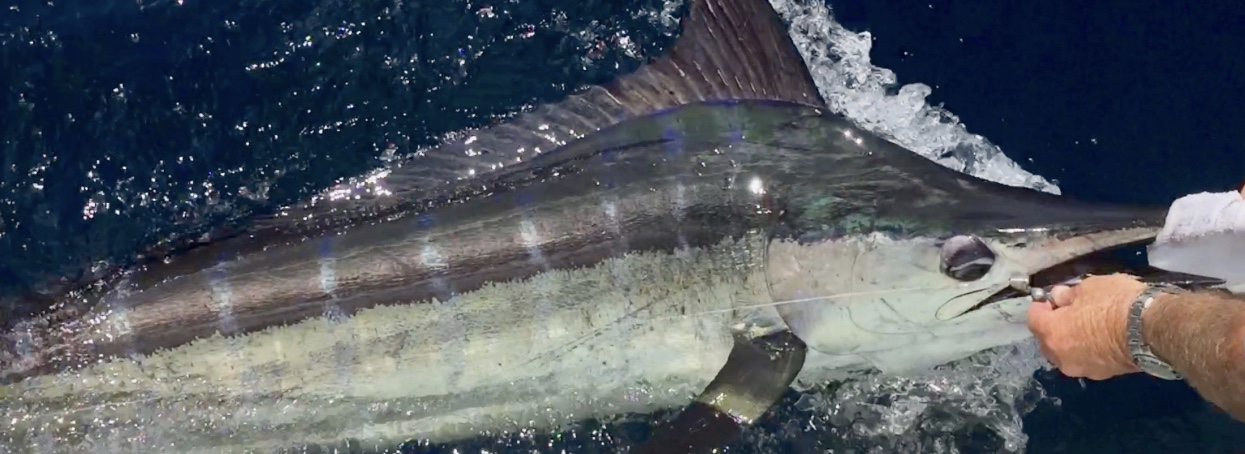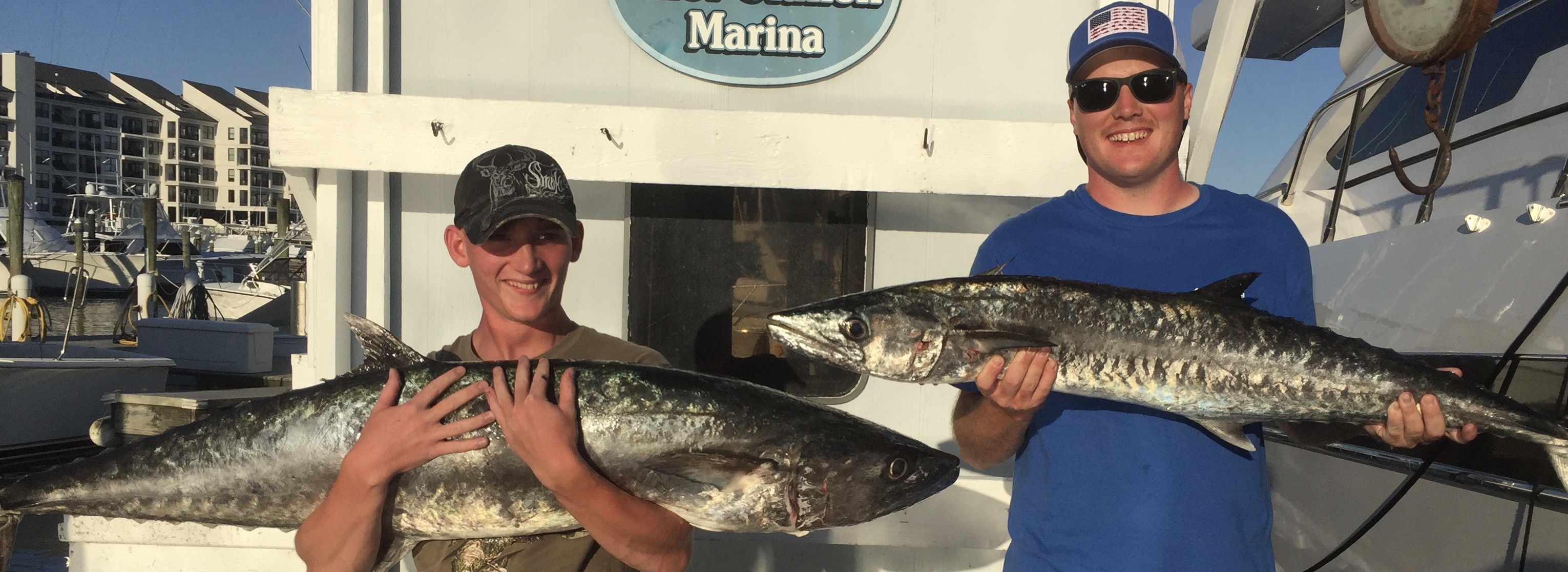Yellowfin Tuna
Thunnus albacares

Tuna Family
Saltwater Fish Identification
[Yellowfin Tuna]
Common Name(s):
Yellow-Finned Albacore, Autumn Albacore, Allison Tuna, Ahi
Description:
Yellowfin are colored with metallic, dark blue on the back and upper sides, changing to yellow and silver on the belly. The dorsal and anal fins, and finlets are bright yellow. Bigeye, Blackfin, Albacore, and Yellowfin Tuna are similar in shape and are caught together.
Feeding Habits: Yellowfin feed on fishes and invertebrates associated with sargassum. This will occur in at the water’s surface in the open ocean. Foods include larval crabs and shrimps, squids, paper nautilus, flying fish, triggerfish, and jacks.
Range: All Florida, the Bahamas and the Caribbean.
Habitat: The Yellowfin Tuna is found worldwide in warm, temperate waters. Like other tuna, this highly migratory species prefers to swim in deep, oceanic waters in search of food. However, Yellowfin Tuna will run closer to shore than most other tuna. They will
Typical Size: Yellowfin may run anywhere from a few pounds to more than 200 pounds with a maximum weight close to 400 pounds.
World Record:
388 pounds, 12 ounces (IGFA)
Bluefin Tuna

Description: Bluefin have a fusiform body, compressed and stocky in front. The pectoral fin does not reach the origin of the 2nd dorsal fin. The height of the 2nd dorsal fin is greater than that of the 1st dorsal fin. The liver is striated on the ventral surface, and a swim bladder is present. There are 34-43 gill rakers on the first gill arch. The back and upper sides are dark blue to black with a gray or green iridescence. The lower sides are silvery, marked with gray spots and bands. The 2nd dorsal fin is reddish-brown, and the anal fin is dusky with some yellow. The finlets are yellow, edged with black. The caudal keel is black at the adult stage, but is semi-transparent when immature.
Size: Commonly 16 to 79 inches, can grow to 118 inches and 1,500+ pounds.
Range: Bluefin are widely distributed throughout the Atlantic. They are found in the western Atlantic along Labrador and Newfoundland, southward to Tobago, Trinidad, Venezuela, and the Brazilian Coast. Distribution in east Atlantic extends as far north as Norway and Iceland, and as far south as northern West Africa. Also exists in the Mediterranean Sea.
Natural History: Western Atlantic bluefin tuna are sexually mature at approximately age 8 (80 inches Curved Fork Length). Eastern Atlantic bluefin are sexually mature at about age 5 (60 inches CFL). Atlantic bluefin tuna spawn in the Gulf of Mexico (April - June) and in the Mediterranean Sea (June -July).
Bigeye Tuna
Thunnus obesus

Saltwater Fish Identification
Common Name(s):
Bigeyed Tuna, Bigeyed Tunny
Description: The Bigeye Tuna is very similar in looks to the Yellowfin Tuna, even down to the yellow inlets edged in black. However their anal fin and second dorsal fin will never reach nearly the same length as that of a Yellowfin. The gold stripe common to the Yellowfin is usually absent, but may be dimly present. The eye is indeed larger, but this might not be readily apparent without a side-by-side comparison. A scientist might have to examine the liver to be perfectly sure of identification with some specimens, but anglers seldom have to worry, simply because the Bigeye is a rare catch, whereas the Yellowfin is common in many areas.
Feeding Habits: Bigeye Tuna will follow mullet, herring, mackerel, flying fish, whiting, and other schooling baitfish. They will also feed on squid, eels, and crustaceans.
Range: It is uncommon but present off all Florida coasts, the Bahamas and the Caribbean.
Habitat: Like the other tuna, this is a highly migratory fish. As the name bigeye suggests, these schooling fish spend most of their time deep beneath the ocean’s surface. During daylight hours, they will stay at depths of roughly 100 feet.
Typical Size: Bigeye commonly grow to 100 pounds and can reach up to 300 pounds.
World Record: 435 pounds, 0 ounces (IGFA)
Coryphaena hippurus

Common Name(s): Common Dolphin, Mahi Mahi
Description: The body of the dolphinfish is quite slender but fairly deep, with a noticeable tapering from head to tail. The male of the species is distinguished from the female by its high, vertical head. The anal fin has approximately 30 soft rays and stretches over half of the length of the body. The distinctive dorsal fin is long, covering almost three-fourths of the body, and has around 60 soft rays. The caudal fin is deeply forked and contains no spines.
Feeding Habits: The Dolphinfish feeds on a diet on mainly on flying fish and squid.
Range: The Dolphinfish is found worldwide in tropical and warm temperate seas, inhabiting the surface of the open sea.
Habitat: Dolphinfish are a warm-water fish usually found in deep waters, close to the surface. While sometimes found in coastal waters, they often concentrate in the open ocean around floating objects such as buoys, driftwood and seaweed clusters.
Typical Size: The Dolphinfish can reach a size of almost 7 feet in length and 80 pounds in weight.
World Record: 87 pounds, 0 ounces (IGFA)Red Drum
Sciaenops ocellatus
Teraotyrys akbudys

Description: The White Marlin is dark blue to chocolate brown overall, shading to sliver on the sides and a white underbelly. The lateral line is clearly visible and runs straight from the tail along the center of the body, becoming curved beneath the dorsal fin. Whites are often confused with Striped Marlin, but the difference can be seen in the pectoral fins. The White Marlin’s fins have rounded tips whereas the Striper’s are pointed.
Feeding Habits: White Marlin will feed on squid, herring, and sardines.
Range: The White Marlin is found off the blue ocean water of all Florida coasts and throughout the Bahamas and the Caribbean.
Habitat: White Marlin typically roam deep waters, they will also approach areas that are normally too shallow for other marlin.
Typical Size: The average sizes of the White Marlin is 40 to 70 pounds, but are not uncommon to 100 pounds and can reach up to 200 pounds.
World Record: 181 pounds, 14 ounces (IGFA)
Makaira nigricans

Common Name(s): Atlantic Blue Marlin, Pacific Blue Marlin, Cuban Black Marlin
Description: The Blue Marlin is dark blue overall with a silvery-white belly. The Blue Marlin has retractable fins that can be folded flat against the body even after death. The dorsal fin stands high (although it is not as tall as the fish’s body-depth) and is pointed anteriorly, rather than curved. It has a large anal fin and lavender stripes that appear when excited but fade after death. The lateral line is not visible in adults without removing scales.
Feeding Habits: They will consume most any baitfish presented to them but their preferences are mackerel, squid, dolphin, and tuna.
Range: The blue marlin is found primarily in the temperate and tropical regions of the Atlantic and Pacific Ocean
Habitat: Occurring offshore in blue oceanic waters, the blue marlin prefers to stay in the warm waters near the surface, above the thermocline. They follow the seasonal water temperature changes, being closely tied to these warm waters. They are found in ocean wat
Typical Size: Most Blue Marlins are between 150 to 500 pounds and many can be found weighing over 500 pounds.
World Record: 1402 pounds, 2 ounces (IGFA)
Wahoo
Acanthocybium solandri

Common Name(s): Ono, Oahu Fish, Pacific Kingfish, Ocean Barracuda
Description: The Wahoo is steel blue above and pale blue below the lateral line. There is a series of 25 to 30 irregular, blackish-blue, vertical bars on the sides. The stripes are less noticeable in larger specimens, but may become more prominent when the fish becomes excited. A distinguishing characteristic is the toothy, movable upper jaw. Also, gill rakers are absent in this species.
Feeding Habits: Wahoo are voracious eaters that will feed on a variety of open-water baitfish. Pilchards, flying fish, mullet, scad, small mackerel, small tuna, porcupine fish and squid constitute the larger portion of the Wahoos’ diet.
Range: Wahoo are found offshore of all Florida coasts, especially the Keys, but are more plentiful in the Bahamas and many Caribbean Islands.
Habitat: Wahoo roam the deep blue water and are commonly found near drop-offs, seamounts, weed lines, and wrecks. Wahoo are migratory fish that are occasionally found in loose groups of 2 to 7, however they will never school.
Typical Size: Wahoo are common at 10 to 50 pounds, but often grow up to 80 or 90 pounds. The can reach weights up to 150 pounds.
World Record: 158 pounds, 8 ounces (IGFA)
King Mackerel
Scomberomorus cavalla

Common Name(s): Yellowtail, Yellowtail Kingfish, Kingfish
Description: The back of the King Mackerel is a iridescent bluish green, the sides are a silver, it has a streamlined body with a tapered head, there are no black pigments on front of the dorsal fin, there is a lateral line that starts high and drops sharply below the second dorsal fin, and young fish often have yellow spots like the Spanish Mackerel.
Similar Fish: Cero, Spanish mackerel,
Feeding Habits: The King Mackerel primarily feeds on fish including Herring, Silversides, and also have been known to eat squid, and shrimp.
Range: The King Mackerel is found along the western coast of the Atlantic Ocean from Massachusetts to Rio de Janeiro, Brazil and the Gulf of Mexico. The Atlantic Ocean and Gulf of Mexico stocks mix in south Florida waters.
Habitat: The King Mackerel prefers outer reefs and coastal waters. They can also be found in northeast Brazil, Louisiana, and south Florida waters. King mackerels are found in depths between 75.5 - 111.5 feet (23 - 34 m). Dependent upon warm temperatures, king mac
Typical Size: The King Mackerel is approximately 20 pounds.
World Record: 93 pounds
Spanish Mackerel
Scomberomorus maculatus

Description: Spanish Mackerel are greenish with silver sides and belly. Yellow or olive oval spots traverse the body, which is covered with very tiny scales.
Similar Fish: Cero, King Mackerel
Feeding Habits: Spanish Mackerel feed on herring, menhaden, mullet, anchovies, shrimps, and squids. Feeding Spanish Mackerel are often seen forcing schools of small fish into tight bundles, nearly pushing them out of the water.
Range: All Florida coasts, Cuba and Hispaniola; not present in most Caribbean Islands or the Bahamas.
Habitat: The Spanish Mackerel are largely coastal, but the do roams offshore at times. They prefer open water but can be found over grass flats and reefs.
Typical Size: Spanish Mackerel are common at 1 to 3 pounds, but not too unusual at 5 to 7 pounds. They can reach a weight of over 10 pounds and may attain a length of over 20 inches.
World Record: 13 pounds, 0 ounces (IGFA)

Common Name(s): Red Bass, Channel Bass, Drum, Redfish
Similar Fish: Black Drum
Feeding Habits: The Red Drum is a bottom feeder and enjoy a diet crabs, shrimps, sand dollars, and fish such as menhaden, mullet, pinfish, pigfish, searobin, lizardfish, spot, Atlantic croaker, and flounder.
Range: The Red Drum is found along the coast from New York to Florida, west to Laguna Madre, Mexico. They are most abundant from Florida to Texas.
Habitat: Red Drum are a favorite target species for coastal and inshore species alike. They will live a long time in estuaries, mud/grass flats, and other shallow-water environments and then move to deeper waters as they grow larger. Many will migrate through inl
Typical Size: Red Drums are caught from less than a pound to 10 or 12 pounds, reaching a maximum in length of 5 feet and weighing up to 100 pounds.
World Record: 94 pounds, 2 ounces (IGFA)
Black Drum
Pogonias cromis

Common Name(s): Drum, Striped Drum
Description: The Black Drum has a short, deep, and stocky body with a high arched back and a slightly concave tail. The lower jaw sports numerous barbels, or short whiskers. There are large pavement-like teeth in the throat, and the mouth is low. The dorsal fins have 11 spines, 20 to 22 dorsal rays, and 41 to 45 scales along the lateral line, which runs all the way to the end of the tail. There are 14 to 16 gill rakers on the lower limb of the first arch. Its coloring is silvery with a brassy sheen and blackish fins, turning to dark gray after death. Juveniles have four or five broad, dark, vertical bars on the body. The common term "drum" refers to the loud and distinctive "drumming" noise that occurs when the fish raps a muscle against the swim bladder. The noise is voluntary and is assumed to be associated with locating and attracting mates, and it can sometimes be heard from a good distance, even by people above the water.
Similar Fish: Redfish, Atlantic Croaker
Feeding Habits: Black Drums feed on fishes, crustaceans, and oysters, which they crush with their huge pharyngeal teeth.
Range: From Gulf of Maine to South Florida; Gulf of Mexico west from South Florida to Laguna Madre, Mexico; Brazil.
Habitat: The preferred habitat is coastal waters including bays, sounds, and inlets where salinities range from near fresh to sea strength. They are commonly found near bridges, piers and other manmade structures.
Typical Size: The average size of the Black Drum is 30 to 50 pounds but they have been caught at over 100 pounds.
World Record: 113 pounds, 1 ounce (IGFA)
Tautog

Alternate common names: Blackfish, Chinner.
Color: Males and older fish are uniformly olive green, dark chocolate, or black in color with irregular mottling along the sides. Females and juveniles are paler in color with large mousy brown and grey mottling on the sides.
Size: Up to 22 inches long.
Habitat: Open water near rocky shores, pier docks, breakwaters, mussel beds; juveniles observed near eelgrass and seaweed beds, rock and cobble bottoms.
Seasonal appearance: All year, most commonly seen from April through November.
Description Tautogs are heavy, stout fish with broad tails and a high, arched heads. They are the northern relatives of the family of wrasses, common in tropical waters. Tautogs are related to, and often confused with, another species of wrasse known as the cunner. The tautog has a blunt snout with a small mouth, thick lips, and strong conical teeth. They have a scaleless cheek region that is smooth to the touch. Their dorsal fin extends the length of the back and has sharp spines.
Tautog become blacker in color as they grow older, and their coloring also varies depending on the local bottom habitat. The distinguishing feature of the adult male tautog is the large protruding forehead. Mature males are often referred to as "chinners" because of the white patch on the chin.
Life History and Behavior Tautog feed entirely on invertebrates, including crabs, mussels, mollusks, sand shrimp, amphipods, and worms, using their strong back teeth to crush hard shells. These fish are not active swimmers. When not feeding, they often gather in groups under the safety of a ledge or hole in the rocks, sometimes lying on their sides. Although, tautog are active during the day, they remain close to cover. At night, they are quiet and inactive, hiding from predators. Juvenile tautog stay near the sites where they were hatched, and are frequently found on eelgrass beds where invertebrates are abundant. The adults gather around rocky bottoms, ledges, pilings, and submerged wrecks.
Cobia
Rachycentron canadum

Description: The Cobia is a long, slim with a broad depressed head and the lower jaw projects past upper jaw. The dark lateral stripe extends through the eye to its tail. The first dorsal fin is comprised of 7 to 9 free spines and when it is young it has conspicuous alternating black and white horizontal stripes.
Feeding Habits: The Cobia feed mainly on crab, squid, and small fish.
Range: Cobia are found both inshore and offshore in warm tropical waters. In North America are mainly found along the Florida coast and the Gulf of Mexico.
Habitat: The Cobia can be found both inshore and near shore inhabiting inlets, bays, and among mangroves; frequently seen around buoys, pilings, and wrecks.
Typical Size: The Cobia average around 30 pounds but it is not uncommon to catch a 70, 80 or even a 90 pound fish. They can reach over 6 feet in length.
World Record: 135 pounds, 9 ounces (IGFA)
Current Virginia Beach Tides
Thursday November 27th, 2025
04:57 PM
NAN ft
+-INF ft / hr
 Next: High
Next: High
+ ft
04:57 PM
+-INF ft / hr

+ ft




